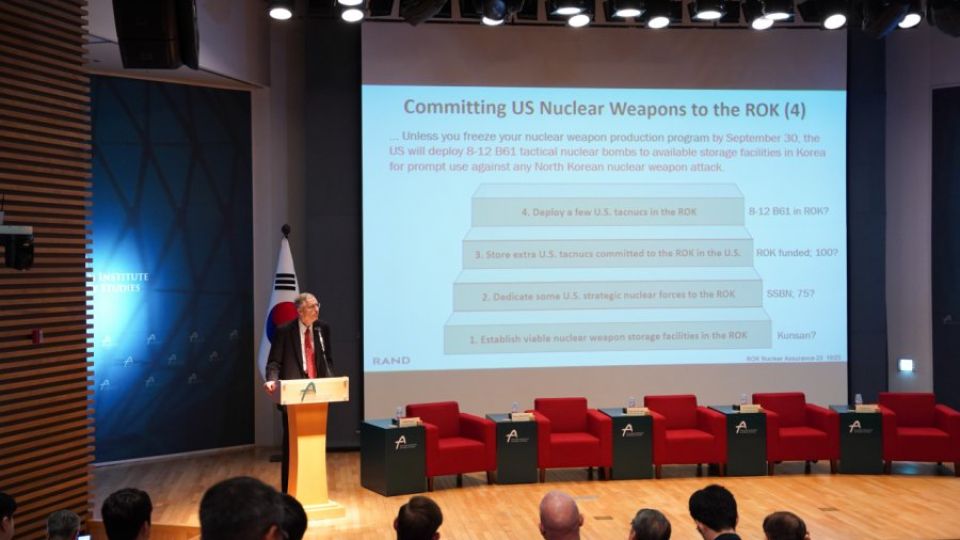October 31, 2023
SEOUL – The United States should reconsider its policy of strategic ambiguity and shift toward one of strategic clarity in response to North Korea’s escalating nuclear threats, one South Korean think tank said in a joint report with a US think tank in a press briefing Monday.
The Seoul-based Asan Institute for Policy Studies and the RAND Corporation, headquartered in Santa Monica, California, emphasized what they say is the need for the two allies to adapt their current nuclear policies and measures to enhance nuclear assurance for South Korea corresponding to North Korea’s advancing nuclear capabilities.
The two think tanks suggested that the re-deployment of US tactical nuclear weapons to the Korean Peninsula in stages will be the “most difficult to implement” but will likely have “the greatest impact” on nuclear assurance for South Korea.
The report estimates that, in North Korea, the “300-weapon threshold could almost be reached (by) 2030” if there is “no increase in North Korean nuclear weapon production,” based on the estimated speed of such production.
A single nuclear weapon could result in around 2 million fatalities and severe injuries within the densely populated capital city of Seoul, the report added. The estimate is based on the calculation that the yield of approximately 230 kilotons was produced during North Korea’s sixth nuclear test in September 2017.
“ROK assurance in the US nuclear umbrella has faltered because of these growing threats and ambiguity in the US commitment to ROK security, leading to increased calls for the ROK to develop its own nuclear weapons,” the report read, referring to South Korea by the acronym of its official name, the Republic of Korea.
A nuclear umbrella is a guarantee from a nuclear weapons state to defend a non-nuclear state, in this case that the US will defend South Korea. The US’ nuclear umbrella is part of the US’ strategy of extended deterrence, which is its commitment to deter or respond to coercion and attacks on US allies and partners using the full range of its military capabilities, including nuclear weapons.
“Because of these developments, the level of strategic ambiguity of the US nuclear umbrella is no longer appropriate for either deterrence or ROK assurance,” the report continued.
Hence, the US could consider embracing an approach of strategic clarity, similar to its measures taken to defend NATO in the 1960s during the Cold War era, to counter nuclear threats posed by the then-Soviet Union, according to the report.
The report stated that Seoul and Washington “really have little choice but to balance the continuing North Korean nuclear weapon developments by achieving a degree of nuclear weapon parity that will assure the ROK people” in light of North Korea’s development of its nuclear weapons program.
The report argues that one potential approach to improving the strategic clarity of the US nuclear umbrella would be to commit some US nuclear weapons to enhancing South Korea’s security.
This approach would involve four steps that could be implemented gradually, with each stage representing a nuclear posture option designed to respond to North Korea’s nuclear weapon buildup, and to freeze North Korean nuclear weapons production and the production of critical nuclear materials. If the US and South Korea are unable to halt North Korea’s nuclear production at any given stage of the plan, they can proceed to the next stage.
The approach would begin with the modernization or construction of US nuclear weapon storage facilities at the US Kunsan Air Base in North Jeolla Province and at the Osan Air Base in Gyeonggi Province.
The second stage would involve dedicating all or a portion of the nuclear weapons to a US ballistic missile submarine operating in the Pacific Ocean so as to target North Korea.
The third stage would be the modernization of around 100 tactical nuclear weapons at South Korea’s expense. The weapons would be stored in the US but remain committed to supporting South Korea.
The final step of the approach would be the deployment of a limited number of US tactical nuclear weapons to South Korea, which would be stored in the previously prepared nuclear weapon storage facilities at the US Air Force’s bases on South Korean territory.
If all four stages are executed, the US could commit up to around 180 US nuclear weapons solely to South Korea in the next few years and deploy eight to 12 B61 nuclear bombs in South Korea, which would serve both symbolic and operational purposes.
The US deployed tactical nuclear weapons on the peninsula between 1958 and 1991. In December 1991, the two Koreas signed the Declaration on the Denuclearization of the Korean Peninsula, pledging not to produce, possess, store, deploy or use nuclear weapons.
“If ROK and US threats to implement these steps fail to lead to a North Korean nuclear weapon production freeze … further commitments of US nuclear forces in future years could sustain the appearance of nuclear weapon parity with North Korea and avoid the appearance that the ROK needs to produce its own nuclear weapons,” the report said.


